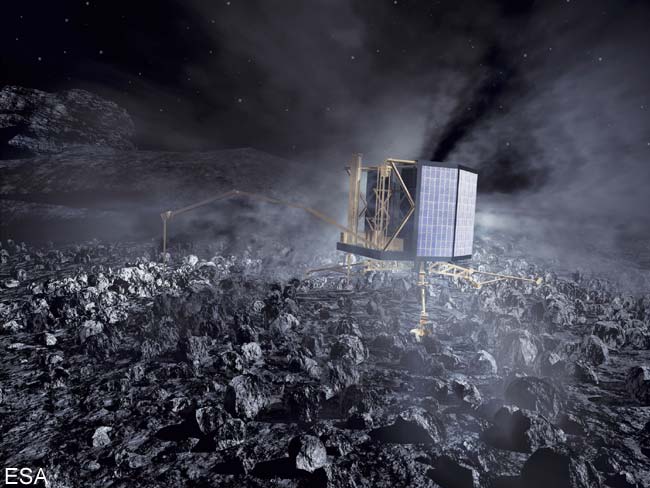ESA Calls on Skywatchers to Track Rosetta Probe's Earth Flyby

TheEuropean Space Agency (ESA) is looking to amateur skywatchersfor help tracking its Rosetta spacecraft, a comet-hunting probe set to swingpast Earth next week.
Rosetta– and its attached lander Philae – is expected to fly by our planeton March 4, though ESA officials expect the spacecraft will be visible viatelescopes and binoculars as soon as Feb. 26. and haveannounced a photography contest dubbed “RossettaUp Close” for homegrown astronomers hoping to catch the spacecraft in theircamera crosshairs.
Launched inMarch 2004, Rosetta has spent about one year in space – about one-tenthof its ultimate journey – playing catch-up to the Comet 67P/Churyumov-Gerasimenko. Rosetta itself is bound to orbit thecomet and study the object as it nears the Sun and begins to outgas material.Later, the Philae lander is designed to harpoon the comet and anchor itselfto the surface for further study.
It appearsthe best view for Rosetta fans – weather providing – will be in Mexico. Thecomet probe will fly over the region as it makes its closest approach to Earthat about 5:10 p.m. EST (2210 GMT) coming within 1,180 miles (1,900 kilometers).
Because ofits current trajectory, the Rosetta-Philae spacecraftcombo should appear from a patch of sky between the constellations Leo and Sextans.
Whileobservers in Europe are not expected to beable to spot Rosetta with the naked eye, they may be able to use video andphoto imaging together with telescopes to catch the approaching spacecraft. Theprobe’s high gain antenna and solar panels, which extend out to 104 feet(32 meters), may also be visible via imaging equipment.
Rosettawill not be silent as it swings past Earth during the upcoming flyby maneuver.Just a few hours before the spacecraft makes its closest approach, the probewill be pointed toward the moon in order to use the natural satellites tocalibrate its onboard instruments.
Get the Space.com Newsletter
Breaking space news, the latest updates on rocket launches, skywatching events and more!
After theflyby, two navigation cameras will be switched on to check Rosetta’s asteroidtracking ability using the moon as a ‘dummy’ asteroid. They will beused to verify Rosetta’s position once the spacecraft drifts past twoasteroids, Steins in September 2008 and Lutetia inJuly 2010.
After itsMarch 4 approach, Rosetta will move faster as it heads west on to its nextplanetary encounter, a flyby with the planet Mars on Feb. 27, 2007. Followingthat Mars boost, the probe will return to swing past Earth twice more to buildup enough acceleration to reach its target comet in 2014.
Observershoping to learn more about ESA’s “RosettaUp Close” contest should visit the spaceagency’s website herefor details as they become available.
Join our Space Forums to keep talking space on the latest missions, night sky and more! And if you have a news tip, correction or comment, let us know at: community@space.com.

Tariq is the Editor-in-Chief of Space.com and joined the team in 2001, first as an intern and staff writer, and later as an editor. He covers human spaceflight, exploration and space science, as well as skywatching and entertainment. He became Space.com's Managing Editor in 2009 and Editor-in-Chief in 2019. Before joining Space.com, Tariq was a staff reporter for The Los Angeles Times covering education and city beats in La Habra, Fullerton and Huntington Beach. In October 2022, Tariq received the Harry Kolcum Award for excellence in space reporting from the National Space Club Florida Committee. He is also an Eagle Scout (yes, he has the Space Exploration merit badge) and went to Space Camp four times as a kid and a fifth time as an adult. He has journalism degrees from the University of Southern California and New York University. You can find Tariq at Space.com and as the co-host to the This Week In Space podcast with space historian Rod Pyle on the TWiT network. To see his latest project, you can follow Tariq on Twitter @tariqjmalik.









